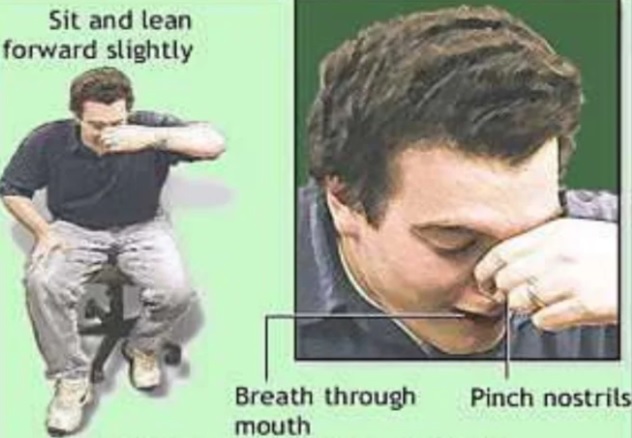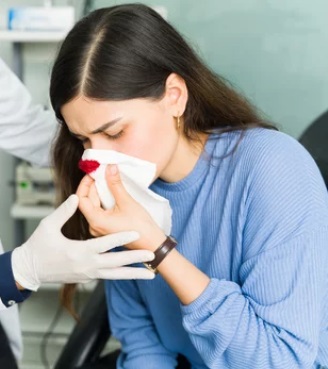We all know that summers in India are hot, humid, and harsh. There are many side effects of such a strong heatwave and the most common ones are dehydration, heat strokes, skin rashes, sunburns, tanning, fainting, and many more.
This blog is written to bring your attention to one more complication faced by many people due to the heat in summer and that is NOSEBLEED. A nosebleed can occur in individuals of any age when the mercury rises.
So what leads to nosebleeds in Summer?
The hot and dry air during summer leads to drying up the protective mucus coating inside the nose. This leads to the rupture of tiny and delicate blood vessels in the nose causing NOSEBLEED.
The drying up of the protective mucus coating in summer also causes excessive crust formation inside the nose which people try to remove by picking their noses. The habit of nose-picking also causes the minute blood capillaries to burst due to trauma.
How to prevent nosebleeds in Summer?
1. Avoid going out in the hot weather.
If you can’t, cover your head with a wet towel and wear a cap.
Also, cover your nose with a wet handkerchief or cotton cloth which helps to avoid hot air coming in.
2. Air conditioners (ACs) and air coolers in the room can help in summer.
ACs and air coolers help by bringing the temperature of the room down and also by maintaining some humidity in the air. This helps in preventing the nose from becoming dry.
3. Avoid blowing your nose hard when it is already dry.
4. Avoid Alcohol, smoking, and hot beverages in summer.
5. Never try to remove the blood clots inside the nose once the bleeding has stopped.
FIRST AID or Home Remedies to stop nosebleeds in summers-
Patients and their relatives are given the following advice if bleeding occurs at home:
1. Avoid frequent cleaning of the nose with tissue paper or finger.
2. Maintain proper nasal hydration with saline nasal drops, saline gels, and ointment eg. Nasoclear® nasal drops/nasal wash, Nasoclear® nasal gel, etc.
3. Increase ambient humidity with a bedroom HUMIDIFIER.
4. Do the TROTTER’S MANEUVER, where the patient sits and leans a little forward over a basin to spit any blood.
The patient breathes quietly from the mouth.
5. It should be followed by the HIPPOCRATIC MANEUVER, where the nose is pinched with the thumb and index finger for about 10 minutes in the same leaning forward position over the basin.
– It usually stops the bleeding from the nasal septum which is the most common site of nose bleeding.

6. Don’t lie down when trying to stop an active nosebleed.
– Lying down can result in swallowing blood and can irritate your stomach which later could cause coffee-coloured vomiting.
7. Release your nostrils after 10 minutes and check to see if the bleeding has stopped.
8. Repeat these steps if bleeding continues.
9. Place a small piece of cotton soaked in decongestant nasal drops. eg. Xylometazoline, or Oxymetazoline.
– (THIS IS NOT ADVISED FOR HYPERTENSIVE PATIENTS, as the decongestant nasal drops might further increase the blood pressure)
10. If the patient is elderly or be it any reason that patient cannot lean forward, no further than 45° leaning back is allowed.
11. Cold compresses or ice-cold water directly over the bridge of the nose results in reflex vasoconstriction and can stop bleeding.
11. Report to an Emergency room in a nearby hospital and see an ENT doctor if bleeding does not stop.
When to seek Immediate Medical Help?
- If the bleeding from the nose does not stop after 30 minutes.
- If the bleeding from the front of your nose is really heavy.
- If nosebleeding is accompanied by other symptoms such as extremely high blood pressure, dizziness, chest pain, and/or a rapid heart rate.
- If the nosebleed is very frequent and occurs three to four times each week or more than once a month.
THANK YOU
MEDICAL ADVICE DISCLAIMER:
This blog including information, content, references, and opinions is for informational purposes only.
The Author does not provide any medical advice on this platform.
Viewing, accessing, or reading this blog does not establish any doctor-patient relationship.
The information provided in this blog does not replace the services and opinions of a qualified medical professional who examines you and then prescribes medicines.
And if you have any questions of medical nature, please refer to your doctor or the qualified medical personnel for evaluation and management at a clinic/hospital near you.
The content provided in this blog represents the Author’s own interpretation of research articles.
